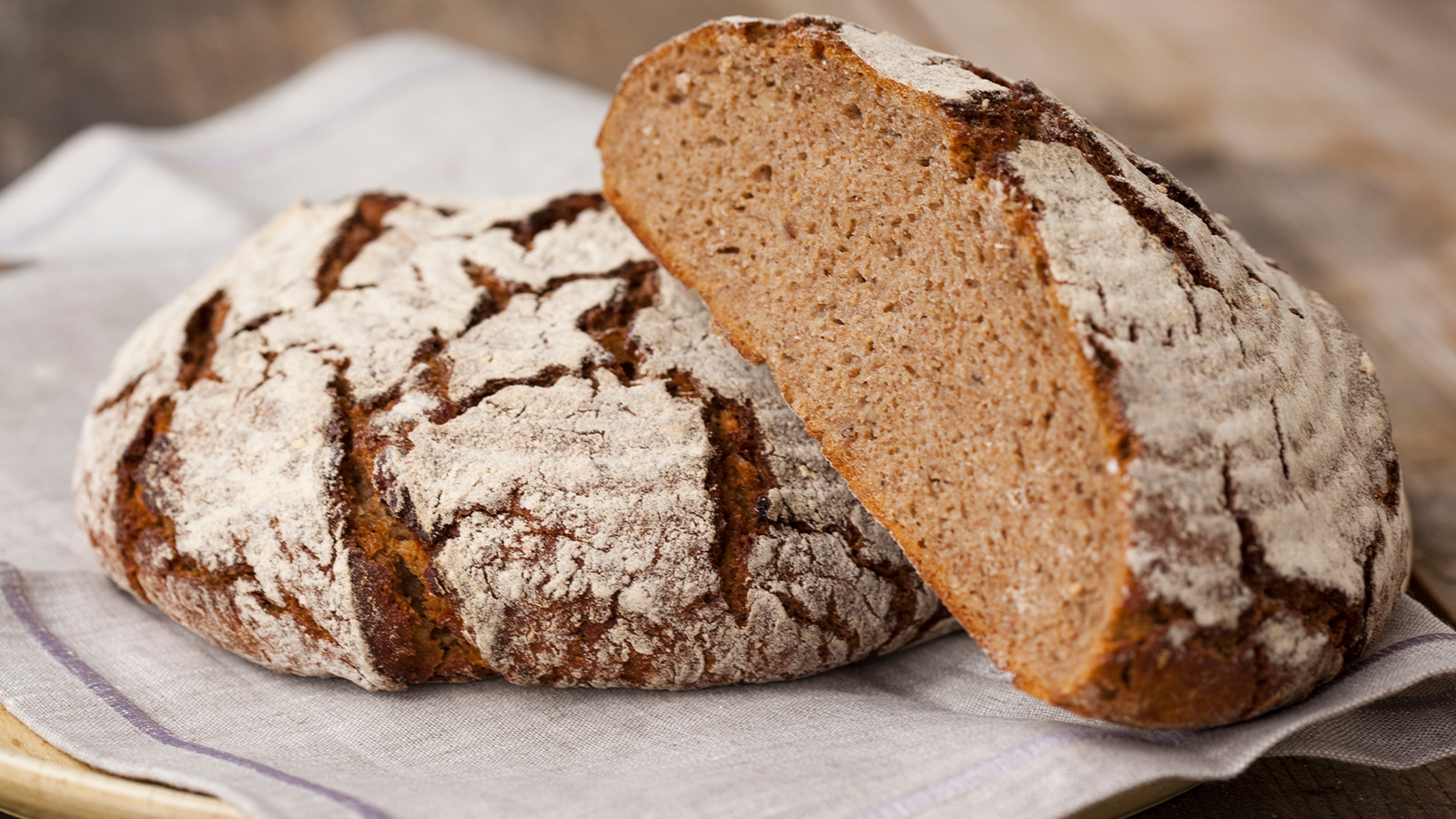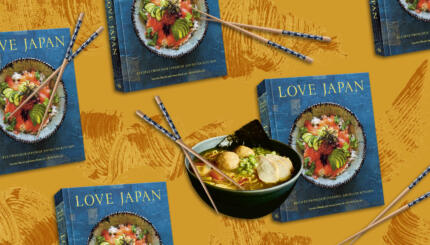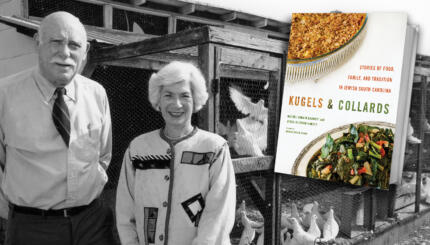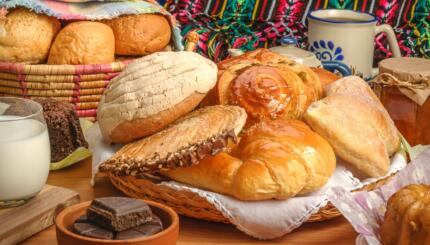The first meal my future mother-in-law, known as Oma, served me featured her homemade Latvian sourdough rye bread and hot borscht. John’s family was not Jewish; his mother’s borscht, made with beef, was nothing like my Jewish mother’s vegetarian version. The soup, however, was not the point. Oma’s sourdough rye was the centerpiece, and my response to this talismanic Latvian food was a test of my suitability as a daughter-in-law.
Sitting at Oma’s Formica table, the three of us contemplated our bowls, silently swirling the sour cream, watching as the broth turned deep purplish pink. Then, John and his mother stared at me as I buttered a slice of grayish brown rye bread and sank my teeth into a slice.
“Firm,” I said.
I sniffed.
The Nosher celebrates the traditions and recipes that have brought Jews together for centuries. Donate today to keep The Nosher's stories and recipes accessible to all.
“Caraway,” I said.
“Sour and yet sweet,” I said.
From their faces, I could see I was on the right track, but more was expected.
“Mushroomy. Reminds me of the forest floor,” I said.
I paused and then did what I do when I don’t know what else to do: I flattered. I gushed. I lied.
“This bread is a tour de force. A masterwork. A doorway into the past when poor people survived on bread alone.” That last part I had right: Latvian rupjmaize made with 100% whole grain rye flour sustained poor people in Eastern Europe for millennia.
But did I like this unfamiliar bread, so tough John used a chef’s knife rather than a serrated bread knife to cut it?
I definitely did not.
I didn’t like Latvian rye bread, and in a secret recess of my heart, I wished John were less committed to it and all the emblems of Latvian culture that separated him from me.
I married John in 1982. My views about rye bread, however, had been formulated decades earlier when visiting my bubbe, Hannah, in the Bensonhurst section of Brooklyn. The gray, mildly tangy, semi-firm bread known as Jewish deli rye — this was rye bread to me. Bubbe bought this rye bread at the corner bakery. It came with seeds and without. She preferred without because the seeds got in her false teeth. I was indifferent, favoring a bagel or bialy made of wheat flour.
In my opinion, rye bread was good for one thing: holding together one of those mile-high corned beef and pastrami sandwiches featured at the Carnegie and Stage Delis in Manhattan. Like many first- and second-generation Jewish Americans, the bread in the sandwich meant less to me than the overflowing portions of fatty meat. In his “Encyclopedia of Jewish Food,” the historian Gil Marks quotes the lyrics of a 1962 song by Alan Sherman:
“Do not make a stingy sandwich; pile the cold cuts high. Customers should see salami comin’ through the rye.”
John thought such overstuffed sandwiches were appalling. He recoiled at the excess. He wasn’t an ascetic — he loved butter, he loved creamed soups. But for him, and for many Nordic people whose forebears eked out a living from the cold earth, the enjoyment of food went hand in hand with a certain restraint. To them a sandwich wasn’t a symphony. It was a delicate duet pairing a slice of rye with a bit of smoked salmon or a slice of meat or cheese, plus a garnish, a gherkin perhaps, for contrast. The minimalism made it possible for John — for anyone — to taste, really taste, each ingredient.
Don’t get me wrong. John was always generous, always enthusiastic about food. He, like me, loved feeding people. He ate well, consuming lots of calories, but his calories were different from mine. This difference, the product of personal inclination and culinary attitudes embedded within our two cultures, existed as a kind of fault line in our relationship.
After we married, Oma continued to bake her rye bread and I continued to not like it. Then Oma’s health failed and she could no longer bake bread. For a while, John ordered Latvian rye bread from a baker in Hartford, Connecticut. When that baker went out of business, John went without.
Then the former Soviet Union collapsed, and everything changed.
In 2004, Latvia joined the European Union. Suddenly it was easy to airfreight rye bread from Riga’s famed Lāči bakery to our home in Maryland.
By then I had begun writing about food professionally. With this new direction in my career came new friends. When John and I served Latvian rye bread with a bit of herring and a tiny tumbler of iced cold vodka to our foodie friends, they went wild. Their enthusiasm cranked open my hard head. Maybe I had been missing something. This firm dark bread with the shiny crust, a little sweet, a little sour, really did taste way, way better than a bagel with smoked fish. It was utterly yummy dipped into the bright yellow yoke of a fried egg. Gorgeous with Roquefort, my favorite cheese, and a glass of red wine.
I woke up one morning and told John my next book would be called “The Rye Bread Marriage.” The title had come to me in a dream. I would, as the rye bread apostate, throw myself into a world, culinary and cultural, unknown to me.
As I researched the book, everything I thought I knew about Jewish rye bread flipped. It turns out Jewish deli rye, which is made with more wheat flour than rye, is an American innovation (quality bakers often use 60% wheat and 40% rye). Sure, my bubbe ate Jewish deli rye in Brooklyn, but in Slutsk, the shtetl in Belarus where she lived in abject poverty with her mother as a small child, poor people like her would have eaten rye bread with no wheat.
I began to suspect the rye bread that sustained her and other Jews living near Belarus was a densely sour/slightly sweet, 100% whole grain rye that was the same as or substantially similar to John’s beloved Latvian rye bread. (Geographical propinquity, climate and poverty explain this connection — a lot more rye than wheat is grown in Belarus and Latvia. In both these lands, wheat was far more expensive than rye — which helps explain the preciousness of the wheat-based challah eaten on Shabbat.)
It pleased me to imagine that John’s ancestors in Latvia and mine in Belarus ate the same kind of rye bread. Baker and bread scholar Stanley Ginsberg’s remarkable books, “The Rye Baker” and “Inside the Jewish Bakery,” supported my supposition.
When researching rye bread in Eastern Europe, Ginsburg discovered what he called “a deeper layer of rye baking,” one that produced an entirely different, more nutritious kind of rye bread. He concluded that “dense, intensely flavored black breads [had] sustained my grandparents and their grandparents in the villages and towns of Eastern Europe.” Ginsberg cited a Yiddish historian describing the bread eaten by the Jews of Drohitchin, a shtetl in the western corner of Belarus near Poland: “The rye bread could stay good for weeks, and the older it got, the tastier and more delicious it became.”
Bingo! The Latvian rye bread I had been eating for breakfast with peanut butter and honey stayed fresh in our bread drawer for weeks.
I had my proof. I was flabbergasted and delighted. What started as a gulf separating John and me — the rye bread we favored, the traditions we inherited — wound up binding us even more closely together. This discovery radiated in all sorts of directions, deepening my sense of kinship with my husband and also deepening my understanding of where I come from.
This is the bread that my great-grandmother fed my bubbe. This is the bread John and I fed our children. This is the bread our children now feed their children.
Read more of Michaele Weissman’s story in her memoir “The Rye Bread Marriage: How I Found Happiness with a Partner I’ll NeverUnderstand.”



